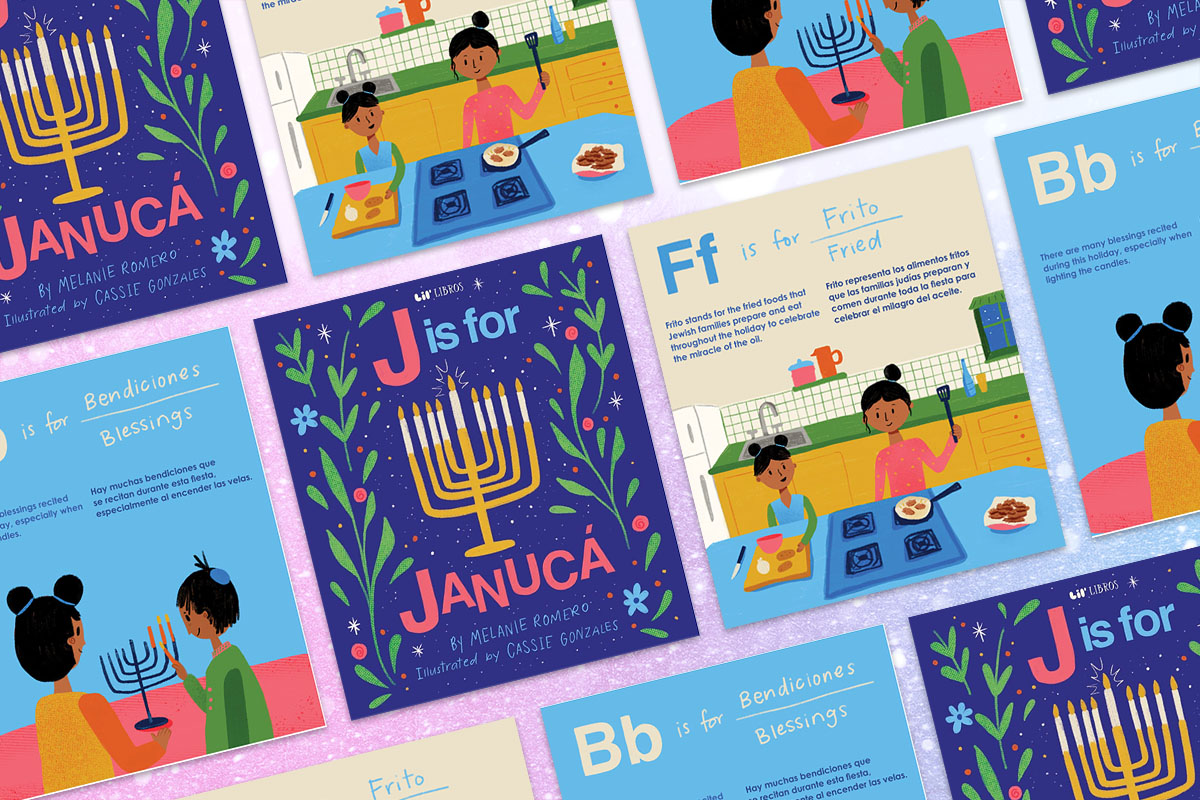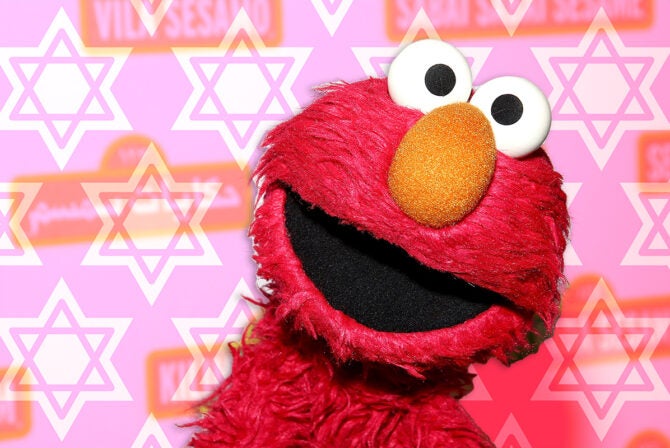As a mom to a 4-year-old and a toddler, I love me a good ABC book — or abecedarian book, if you’re fancy. A new Jewish ABC book that came out this October may be one of my new favorites.
“J Is For Janucá” is a bilingual Spanish-English ABC book illuminated by the cheerful illustrations of Casie Gonzales. This book is Gonzales’ debut as a children’s book illustrator; the gifted book cover designer beautifully distills the joy of Hanukkah with a great color palate and impeccable sense of design.
The book brightly celebrates the Jewish festival of lights and Spanish-speaking Jews. It incorporates the Spanish alphabet letter “Ñ” for ano, as well as the Spanish “Rr” for the word tierra — land, “Ch” for chocolate, and “Ll” for lleno — full. It’s full of Jewish trivia, touching on our lunar calendar, Jewish exile, the hamsa, Yiddish and more.
There are so many reasons why I’m glad this book exists: It’s a beautiful addition to Hanukkah kids’ lit for Jewish Americans — especially Latinx Jews who don’t have many books catered to them. It’s a way to introduce non-Spanish-speaking Jewish children to a new language early on. And it’s also a great introduction to the Jewish holiday for Spanish-speaking homes; after all, Spanish is the second most popular language in this country.
Author Melanie Romero wrote the book to “spotlight the pockets of Jewish communities in Latin America and American-Latinx spaces that are often overlooked and deserve the attention and recognition.” Romero, an editor at Lil’ Libros, which published the book, grew up in a Spanish speaking household — both of her parents are from Mexico City. Yet she only reconnected with her father’s Jewish heritage as an adult, after his passing; she has written about the experience for our partner site Hey Alma.
Romero dedicated the book to her twin sister Caitlin and to the Jewish-Latinx community that “welcomed us home.”
Kveller spoke to Romero about the inspiration behind this book, the complexities of putting together a bilingual Jewish book and what she hopes readers will take from “J Is For Janucà.”
This interview has been condensed and edited for clarity.
What inspired you to write this book?
This is a hard question to answer because there are so many reasons!
As a children’s book editor, it’s heartbreaking to see winter holiday displays picking one religious-traditional holiday over others, and leaving little ones that celebrate other holidays out of the holiday spirit.
But, as a Jew, I wrote this book to spotlight the pockets of Jewish communities in Latin America and American-Latinx spaces that are often overlooked and deserve attention and recognition; I chose to honor Hanukkah because it’s the holiday that made me fall in love with being Jewish and the one I continue to celebrate with my sister. Coming from interfaith backgrounds, it’s easy for us to pick one religion over the other, but we [try to] hold this idea that our mixed heritages are what makes us culturally aware. Also, there’s no greater joy than to have an abecedarian book that uses the Spanish alphabet (we even included Ch, LL, and Ñ) over the English alphabet to [connect] Spanish words (that reflect Hanukkah and Jewish identity) to each letter of that alphabet.
What does Hanukkah mean to you?
I sadly didn’t grow up celebrating Hanukkah, and it wasn’t until my third year of college that I found any interest in practicing and learning about Judaism. My sister, Caitlin, who is proudly Jewish, really instilled a love of the religion and culture in me, and although I found myself gravitating to a more secular outlook on Judaism, I discovered the importance and togetherness of holidays, such as Hanukkah.
Hanukkah, at least for my sister and me, is a time to celebrate our sisterhood and friendship, when the traditions we love best are upheld. There’s no better time than making homemade latkes and sufganiyot, lighting the candles of the menorah and spending our nights eating gelt. The beauty of Hanukkah is that everyone celebrates in their own way and for their own reason!
Why do you think it’s important for there to be Jewish books that include Spanish?
As I mentioned, Jewish-Latinx communities do not receive enough recognition.
There is still the overarching assumption that the Latinx community is Catholic, and although the majority of it is, there exist many pockets of Jewish communities in Latin America — and even in the U.S. I think there should be a book on the Jewish experience available on display stands if we truly believe in diversifying the voices and narratives of an extremely white publishing industry. This book connects two worlds: what it means to be Latinx and Jewish. It also gives insight to a readership that may be of different backgrounds or beliefs, but wants to be culturally aware. And what better way to expose them to a holiday they little or nothing about while targeting their language skills?
Tell me a little bit about the process of deciding what elements to incorporate into this book.
This book is authored in regards to my own Jewish experience and illustrated in the eyes of Cassie’s own childhood and upbringing; our lived-in experiences are visible throughout the book But, I also didn’t want to make it so specific to our own experiences that someone would feel left out, so I did my best with the manuscript to incorporate universal elements: lighting the candles, reciting blessings, eating fried foods, reading the Hanukkah story, commemorating the miracle, remembering the cruse of oil… everything that’s at the heart of this holiday, no matter where you’re from or how you practice it. These elements tell a general recap of Hanukkah and of Jewish identity, but it’s done in a way to also make it inclusive for anyone.
Both you and Cassie are Jewish with Mexican connections — was it important to you to collaborate on the visuals with a Jewish person?
I don’t think I would have felt comfortable if we hadn’t found someone who is Jewish to illustrate! I think “own voices” books need to be exactly that: the voices of authors from the community who seek to represent their community to the world, one page or illustration at a time.
I had actually found Cassie’s artist profile online months before this manuscript came to be, and when we were trying to find an illustrator for this project, I remember Cassie being at the top of my list. We have very wildly different upbringings and experiences as Latinx Jews, but I couldn’t have asked for anyone other than Cassie to represent the Jewish community, while also tending to the Latinx roots in us.
There are a lot of elements of Ashkenazi Jewish culture in the book! Is that a conscious choice?
I’ll be honest — it was a very easy, but also very complicated process to write the manuscript for this book. During a sales conference, my then-editor curiously, “What if we [make] a Hanukkah alphabet book, but we title it in Spanish, maybe something with the word Janucá?” It took me about an hour to find words in Spanish that reflected Jewish identity and the holiday itself.
I didn’t consciously choose to have Ashkenazi Jewish culture in the book; a lot of the words I chose tied into my own experience and what I witnessed and celebrated at home. Cassie also related to most of the words I had chosen in terms of her upbringing. We did bring an authenticity reader into this process, and their feedback definitely expanded beyond my own knowledge of what it means to be Jewish.
Who are your ideal readers? What are you hoping that children and parents will take from this book?
This book is a love letter to the Latin American and American-Latinx communities that come from a cultural and/or religious Jewish background. But our readership isn’t pigeonholed to one community; it’s a book that’s meant to traverse limitations and be a cultural, insightful book about the miracle of Hanukkah from a Jewish perspective for anyone willing to pick up the book and read it. Cultural awareness starts with a curious mind and a desire to educate yourself and others about diverse experiences.
I hope parents and little ones — Jewish or not, Latinx or not — will gain insight into the community and learn about the traditions Jews observe during this holiday and what it means to us.
Is there anything else you’d like our readers to know?
As Editor of Lil’ Libros, it makes my lil’ heart brim with joy to see our books out in the world. Whoever takes the time to pick up our books, I hope you get love and light out of them, and that these bilingual books from a Latinx-focused, community- and women-owned publishing company make you dream in two languages. I hope they encourage you to fight for the stories you want to see in the world that are a reflection of you.
Buy the book on Lil’ Libros / Amazon / Bookshop.org








